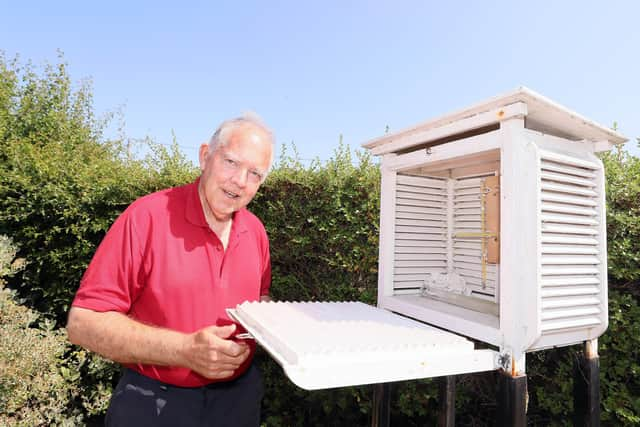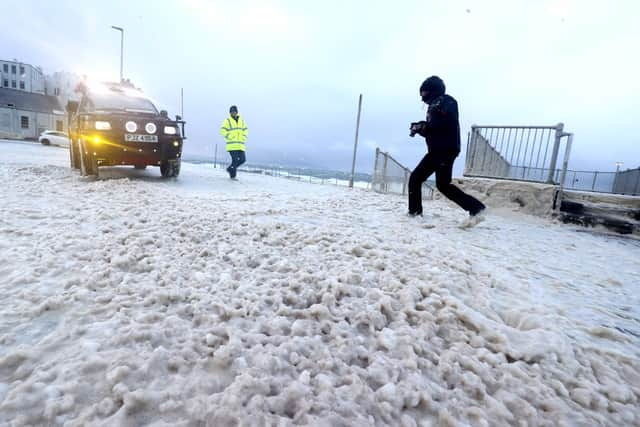2021 Weather in review: The year that put Ballywatticock on map
and live on Freeview channel 276
Meteorologist Dan Stroud provided the following month-by-month round up of a topsy turvy year of weather in the United Kingdom:
• January
Generally cold, average temperature was 2.2°C which is 1.5°C below the 1981-2010 average, making this the coldest January since 2010.


• February
Advertisement
Hide AdAdvertisement
Hide AdCold start, with -23°C recorded at Braemar in Scotland. Turned much milder as the month progressed.
• March
A very average month


• April
Began settled but turned unseasonably cold with a notable number of air frosts. The provisional UK mean temperature was 5.7 °C, which is 1.7 °C below the 1981-2010 long-term average, with April being colder than March for the first time since 2012.
• May
Began very unsettled and unseasonable cold, mean temperature were 9.1°C which is 1.3°C below the average.
Nearly all areas had a wet month, many places from eastern Scotland to Wales and south-west England had well over double their usual May rainfall, making it provisionally the UK’s fourth wettest May in a series from 1862, with 171% of average.
• June
The first half of June was largely dry and warm.
Advertisement
Hide AdAdvertisement
Hide AdThe second half saw temperatures broadly nearer to average. The provisional UK mean temperature was 14.2 °C, which is 1.2 °C above the 1981-2010 long-term average.
• July
The first 12 days of July were mostly unsettled, with spells of heavy rain and showers.
All areas were drier and much warmer by mid-month, with temperatures exceeding 30 °C on several days in some areas, and unbroken sunshine for many.
In NI, 31.3 °C was recorded on July 21 at Castlederg, Co Tyrone, setting a new record as the highest temperature for any month.
Advertisement
Hide AdAdvertisement
Hide AdIt beat the previous record of 31.2C, which was set at Ballywatticock in Co Down four days earlier.
The provisional UK mean temperature was 16.6 °C making the month the equal fifth warmest July for the UK since 1884.
• August
Many places drier than average with less than half the normal rainfall, temperatures close to average.
• September
The weather was reasonably settled and quiet, it was also rather warm with a mean monthly temperature were well above average.
Advertisement
Hide AdAdvertisement
Hide AdThe provisional UK mean temperature was 14.7 °C, which is 2.1 °C above the 1981-2010 long-term average.
This was only slightly cooler than August’s mean temperature and ranks it as the second warmest September in a series from 1884.
• October
The weather during most of October was unsettled and wet, the wettest areas were southern Scotland, Cumbria, the north-west corner of Wales, and southern England, with many places above 150% of average, and the UK overall had 128% of average October rainfall. In the 24 hours ending at 9am on October 28, 222.6 mm of rain fell at Honister Pass (Cumbria).
• November
The weather during most of November was on the mild side, with many areas seeing some settled spells, however the last ten days of the month were much colder and more unsettled, with Storm Arwen of note on November 26/27.
——— ———
A message from the Editor:
Advertisement
Hide AdAdvertisement
Hide AdThank you for reading this story on our website. While I have your attention, I also have an important request to make of you.
With the coronavirus lockdown having a major impact on many of our advertisers — and consequently the revenue we receive — we are more reliant than ever on you taking out a digital subscription.
Subscribe to newsletter.co.uk and enjoy unlimited access to the best Northern Ireland and UK news and information online and on our app. With a digital subscription, you can read more than 5 articles, see fewer ads, enjoy faster load times, and get access to exclusive newsletters and content. Visit https://www.newsletter.co.uk/subscriptions now to sign up.
Our journalism costs money and we rely on advertising, print and digital revenues to help to support them. By supporting us, we are able to support you in providing trusted, fact-checked content for this website.
Ben Lowry
Editor